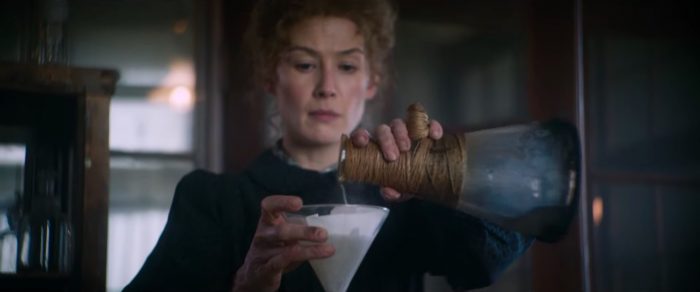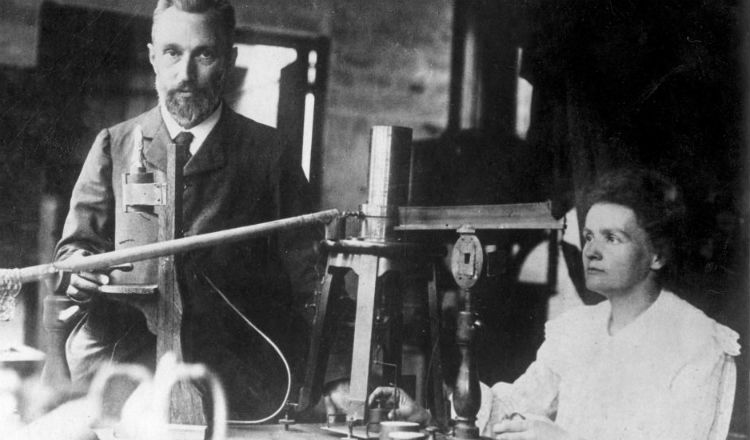By Mado Gianni,
A biographical film or a biopic is a film that dramatizes the life of a single individual who for some reason has marked their footprint in the common history of the world. Big words. And big responsibility on behalf of the filmmakers. Marie Curie did her part as a physicist but Marjane Satrapi failed to deliver an evocative film.
Radioactive is a biopic film that recounts the life of Marie Curie, the famous physicist and two times Nobel Prize winner. It is an extraordinary story in its ordinariness and undoubtedly a story that defines the twists and turns of recent history to a significant extent. Yet, the more exciting the story of the radium element is, the less engaging the film was in delivering a notable message.
The film was produced by Working Title Films in collaboration with Shoebox Films and was distributed by Amazon on Prime Video. The film premiered at the Toronto Film Festival last September as the Closing Night Gala with a set UK date premiere on the 8th of March the following year. Due to the Covid-19 crisis, the premiere was cancelled and the film was digitally released in June. It has been playing on the big screen in certain countries this September.
Radioactive (2019) is based on the graphic novel Radioactive: Marie & Pierre Curie: A tale of love and fallout (2010) by Lauren Redniss. The title of the novel certainly rings a bell and reminds us of the exaggerated dramatization of events that occurs in the film as well as all the romantic elements that serve as points of reference throughout the film. Yet, not many parts of the plot focus on the biopic aspect of the representation of the non-fictional character of Marie Curie. The film might be a faithful representation of the novel, but it fails in its purpose to entertain, educate or impress the viewer. And it is a shame that a truly impressive story with as many major historical implications as this one would fail to impress.
There are some valid sequences in the film which serve as a connecting link between different moments in the history of radioactivity, enabling the script to unravel rhythmically. For example, during the first half hour of the film there is a panning shot of a kid holding a paper kite and running around an area that is seemingly warm and sunny implying that it is either a coastal area or close to the southern hemisphere. The kid runs in front of a man and the camera stays on the man’s face as he is following the child with his gaze. The man eventually turns his head and looks up at something that is falling from the sky. The area of course is Nagasaki. Jumping back and forth in time intensifies the importance of the matter at hand: was the invention of radioactivity a good or a bad thing? This question reappears many times throughout the film either in the form of dialogue between the characters or through similar sequences.

The film also manages to confront the issue of gender inequality in a very thoughtful way. Or at least, the attempt in doing so is noteworthy. Even so, according to many critics as well as scientists the film has not only altered many historical events but has also provided a misinterpretation of several characters including that of Marie Curie herself. That said, the film focuses on the dramatic love between Marie and Pierre leaving the science partly on the side. It is fast forward and it certainly does not do justice to Curie’s character portraying her as a strong woman but a whiny wife. The moments that Curie seems to be putting her foot down are intolerably superficial. For instance, the scene when her daughter brings her husband-to-be over for dinner and Curie asks him about the science feigning any kind of emotional attachment to either of them is strikingly pretentious. On the same note, many scenes put much effort on the inspirational side of events feeding in on the emotional availability of the viewer rather than saying anything at the least more original about the life and story of the first woman ever to win the Nobel Prize.
On a positive note, Rosamund Pike and Sam Riley are not just the only two actors who get screen time in this film, but they also deliver a memorable performance. Also, the set design puts the viewer in the mood of the early 20th century instantaneously. Yet, the orchestration of the different elements and the multitude of information contributing to the character development of both characters do not add up in a stimulating way. Marjane Satrapi’s work on Persepolis (2007) can only vouch for her creativity and vision while Radioactive follows pretty much on the Oscar bait genre steps. I wonder, does anybody really think this is what people want to see?
Providing criticism should always be productive, therefore spotting the inaccuracies or wrongdoings of a film does not render it undeserving of its spectatorship. Watching a film is also an experience and with the right company at the right place, it can be a memorable screening even if the film was not as good as expected. I was in the company of a biochemist who was invested in the film as much as I was. And make no mistake, we were in agreement about the film.





